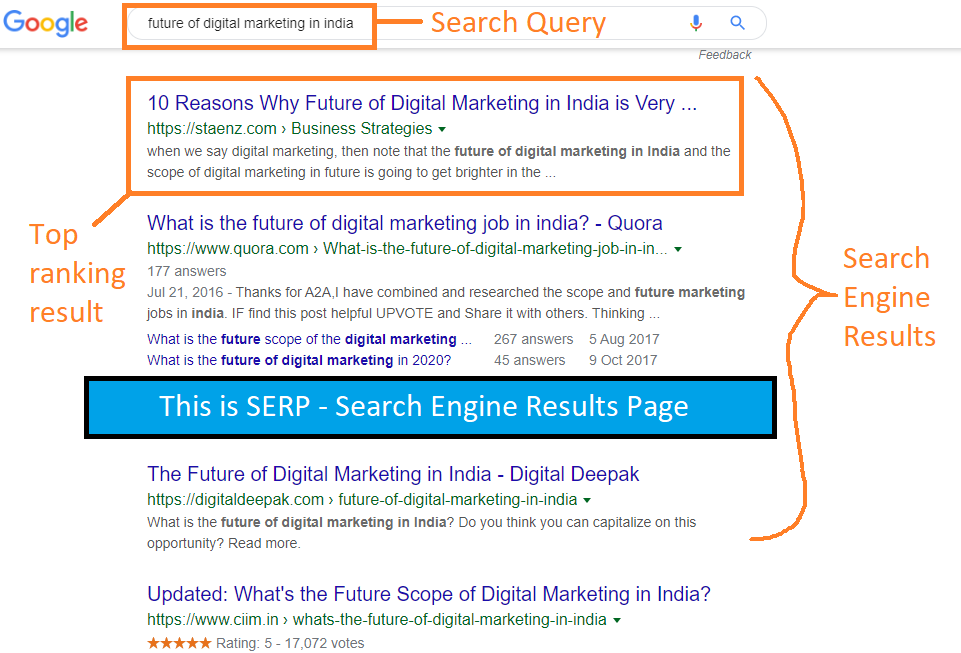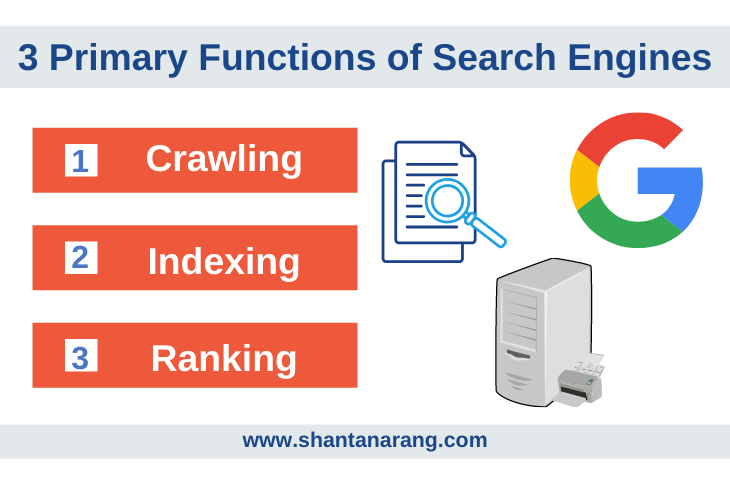SEO for Beginners – A complete guide for search engine optimization
What is SEO?
SEO stands for “Search Engine Optimization“. It is a process of getting the website rank higher on the Search Engine Results Page (SERP) and getting more traffic on the website.
Is getting more traffic is about getting more viewers?
No, it is about getting relevant traffic. Quality Traffic!
The common tasks related to SEO includes the creation of good quality content, optimization of content around the specific keywords and build backlinks.
In simple terms, SEO is nothing but anything done to enhance the ranking of the website on the search engine result page (SERP). When you search for anything in Google search, a page with results relevant to your search is displayed to you. In technical terms, it is known as SERP and the process of ranking higher on SERP is SEO.
Let’s look at an example to understand search engine optimization in a better way.

In the example above, you can see that the search query is “future of digital marketing in India”. It is the normal Google search page. The results which are displayed below are the search engine results and the page which contains these search engine results is the SERP (Search engine results page).
As you can see from the various articles related to the query “future of digital marketing in India”, the top ranking one is the most optimized for this search and ranks on the top position due to SEO.
How does SEO work?
When it comes to SEO, it is very important to understand how a search engine works. This will help in optimizing the website in a better way.
Search engines play the role of answer machines. Search engines always want to provide the best results to the users. They want to deliver the results which are not only good in content but also are relevant to the user. This is achieved by search engine algorithms.
But, at this moment, let us understand about the 3 most primary functions of a search engine – Crawling, Indexing, and Ranking.

#1. Crawling
In order to give the best results, search engines (Google, Bing, Yahoo) crawl different websites to understand what the website is all about. Search engines send out the group of robots known as crawlers or spiders to find new and updated content.
Crawling helps search engines to discover content. The content can be new content or an updated one.
Let us understand this with the help of a small example.
Consider a renowned blogger who writes on Travel. He visits a new destination and writes a blog about that place. This is a new blog and new content for crawlers.
On the other hand, if the travel blogger revisits a place which he previously visited a few years ago. At that time, he wrote a blog about that place. But now, there are certain changes in that place and he updates his existing blog. Search engines are powerful enough to identify this update in his blog and crawl to find out the updated content.
#2. Indexing
Crawling lets the search engine know about new and updated content. Indexing helps search engines to store relevant content.
Indexing is the process in which a search engine collects data, analyzes it and stores it for use.
It is this index that gives the results for search queries by a user. Whenever a user searches anything, the search engine checks it’s index and delivers the relevant results.
Without a search engine index, the search engine would consume more time to show results.
#3. Ranking
Whenever you make a search, you would observe that there are thousands of results. But, few are displayed on the top while others are not. This is because of search engine ranking.
After crawling and indexing, the search engines rank the content on the basis of quality, relevance, site navigation, UX, etc. There are many factors that affect search engine ranking. And, the goal of SEO is to optimize the website as per the search engine guidelines to rank higher in SERP.
But, how does a search engine evaluates and decides which website is to be ranked on what position?
It is with the help of algorithms.
Google is the most widely used search engine. Therefore, let us have a brief overview of the Google Algorithms.
Google Algorithms
Google has a complex algorithm for providing search results that change frequently. An algorithm is a step by step process to achieve a particular goal. Google keeps on updating its algorithms. Whenever a new update of an algorithm is rolled out, it is known as Google Update.
Recently, Google rolled out the BERT update. BERT update will do natural language processing and will analyze the intent of the search to deliver much better results.

Earlier, the algorithms used to focus on keywords to a great extent and webmasters took advantage of this by explicitly stuffing a lot of keywords in order to rank high. Google has drastically changed its algorithms and they are constantly updating it.
Google doesn’t like if you try to cheat it or its users. It wants to deliver relevant and quality results. Therefore, it penalizes websites that try to follow unfair means or don’t follow Google’s guidelines.
Google Penalties
Yes, you read it right. Google charges penalties if you do not follow guidelines and try to rank higher by black hat approach. This is a measure taken by Google to punish a website by de-ranking it if it is not following the laid guidelines.
Google can penalize at various levels. Suppose a webmaster is doing keyword stuffing and his website is ranking. Google can punish by de-ranking the website for that keyword. The penalty can be URL level, domain name level, and de-listing too.
De-listing is the most severe punishment. Google de-lists the website from its index.
Do not worry if you are not able to understand these penalties at this moment. In the next section, I am going to explain to you the difference between black hat SEO, white hat SEO, and grey hat SEO.
White Hat vs Black Hat vs Grey Hat SEO
On the basis of the techniques used by the website owner to rank the website, SEO is of 3 types. We were discussing Google penalties above. Penalties are imposed on websites not following the guidelines and ranked with the help of Black Hat SEO. Let us understand the 3 hats of SEO in detail.
White Hat SEO
White Hat SEO is a practice that enhances search performance on the search engine result page (SERP) by strictly following Google’s Webmaster Guidelines.
Some examples of the tactics consist of using relevant quality keywords, quality link building, and writing content which focuses on relevancy, organic ranking, and user engagement.
White Hat is preferred over Black Hat because it is more ethical and sustained.
Black Hat SEO
Black Hat SEO tactic is the disapproved practices that increase the page rank in SERP by not following the search engine’s terms of service.
The black hat techniques involve keyword stuffing, usage of unrelated keywords in page content, spamming, etc.
Black Hat SEO techniques quite effective in terms of ranking but are risky and can be reported.
Grey Hat SEO
Grey Hat SEO is the SEO technique is riskier than White Hat SEO but less risky than Black Hat SEO as websites may or may not get banned from search engines, it is difficult to define though.
It is important because it can improve the website’s ranking without any negative impact.
Grey Hat SEO categories change periodically so it advised marketers to keep themselves about the latest categorization. It might get website traffic initially but it won’t last for a longer period.
On-Page SEO & Off-Page SEO
On the basis of whether the activities are performed on the website or not, SEO is of 2 types – On-Page and Off-Page. On-Page SEO refers to the factors that can be controlled on the website. Whereas, Off-page SEO refers to the page ranking factor that occurs off-website like backlinks, guest posts, etc.
On-Page SEO
In On-Page SEO, the website content, it’s architecture, navigation, keywords, headings, meta and certain other elements that are present on the website are optimized.
As the optimization takes place on the web page which is to be ranked, it is known as On-Page SEO.
Off-Page SEO
Off-Page SEO, as the name suggests does not take place on the web page. While On-Page SEO emphasis on optimizing the web page, Off-Page SEO emphasis on driving traffic to the web page by creating links for the page at several places.
Search Engine likes links. But, unnecessarily linking just for the sake of it can lead to a negative impact.
Build quality links by sharing content on social media, local business listing, social bookmarking, guest posts, etc.
Technical SEO
Technical SEO is the most crucial step in the complete SEO process. It refers to the optimization of the website and server which help search engines crawl and index the website more effectively to improve organic rankings.
Search engines give preference to websites that have a secure connection, a responsive design or a fast loading time.
Technical SEO has got nothing to do with content, its main objective is the optimization of the infrastructure of the website.
Some best practices for technical SEO are – specific preferred domain, optimize URL structure, navigation and website structure, website speed, mobile-friendliness, etc.
Role of SEO in Digital Marketing
SEO plays a crucial role in digital marketing. It is subject to take website visibility, user traffic, conversion rate, and ROI.
SEO helps to increase brand awareness which means getting a website on the top page of search engine result pages will get a high number of impressions and views. Higher the visibility of the page, the higher is brand awareness.
Digital marketing is incomplete without Search Engine Optimization. Building a website is easy but ranking it higher on SERP requires SEO.
Having an excellent website with no traffic is of no use. Even if you have an awesome website, it will not be discovered by search engines and thereby by users unless you have a website that is SEO-friendly.
I am working in this field for last 10 years and have worked on several search engine optimization projects. On this blog, I aim to share my learning with you all. I will be sharing the ways in which you can rank higher on SERP without getting penalized by Google.
Stay tuned!
Feel free to ask me doubts in the comment section. I will be happy to help you.

You can make more articles on the different aspects of SEO and pass the link juice from this article to the other articles.
Yes, This article is for beginners, and soon I will share the content on Advanced SEO…
it is really nice and informative article for beginners, thnx mam
Thank you, Arun !!!
welcome mam 🙂
Marvellous way of explaining…
Being a digital marketer I do thorough research on different topics. the way you have described the topic is wonderful. The content is very engaging and that is the reason I am appreciating your work. Keep the good work. Great efforts of the content writer.
Thank you, Shashank
Easy to understand guide for beginners..
Great blog post on SEO, really you has written great about SEO concepts which is helpfull for those beginners who want to know about the entire SEO scenerio.
Thank you, Atul
Nicely done, Shanta. Very good article on the basics of SEO.
Thank You, Priya
Such an Informative and crisp article…. Good one
I am a big fan of your blog, you update everything related to digital marketing and also focus on the latest updated algorithm of Google.